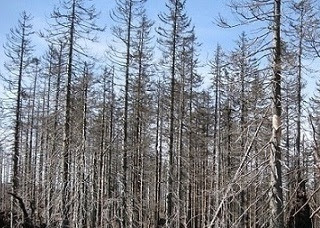What are the harmful effects of acid rain on plants in chemistry?
Effect of acid rain on plants is the most important
matter among the things that are damaged by acid rain.
The various gaseous oxides and acid such as SO2, NO2,
hydrogen chloride etc in the air are mixed with rain water and form H2SO4,
HNO3, HCl respectively that falls on the earth surfaces in the form of acid
rain.
The normal rain water is mildly acidic in nature. The
pH range of normal rain water is 5.6 – 6.9.
But the acid rain is more acidic than normal rain water
due to presence of mineral acids such as sulfuric acid, nitric acid etc.
The pH range of acid rain is 5.6 – 3.5. Due to high
acidity, acid rain has high corrosive nature.
Due to its corrosive nature, acid rain has a harmful effects on plants and can damage a wide spread of forest sometimes partially or
completely.
For example, approximately half of the trees of BlackForest of southwestern Germany’s are damaged due to acid rain.
Since, acid rain drop on leaves of tree, hence it can
damage the leaves partially or entirely.
It also attacks trees more directly by
eating holes in the waxy coating of leaves and needles, causing brown dead
spots.
As a result, photosynthesis process on green leave does
not occur and hence trees can’t produce food. So, it is harmful effects of acid rain on plants.
Again, acid rain increases the acidity of soil and
removing useful nutrients from the soil, it slows the growth of plants. So,
taking of foods from soil becomes problematic for plants.
Hence, the prevention power of plats, against disease
gradually decreases. Also, due to the acid rain the forest ecosystem isdestroyed. Normally, the entire plant world has to face losses.
Soil acidification has also a bad impact on soil fauna
that reduce the productivity of forest.
Due to acid rain, the pH value of soil decreases. That
is, acidification of soil increases.
As a result, the capability of nitrifying bacteria to fix nitrogen decreases soon below pH 5.6.
In areas where there is acid rain, the plants are
severely damaged. Acid rain increases soil acidity. This results in damage or
death to various animals and micro-organisms living in the soil.
Due to the acidity of the soil, the tendency of the
plant to take food from the soil decreases. That is, acid rain reduces the
growth of vegetable such as, pea, beans, radish, spinach, carrot, etc.
Also in more acidic soils or soil with less pH the
decomposition of organic matter is less.
On the same way, hydrogen ions of acid rain leach away
vital minerals and nutrients such as calcium, magnesium, sodium, potassium etc.
- What are the harmful effects of acid rain on plants in chemistry?
- What are the harmful effects of acid rain on humans in chemistry?
- What are the causes of acid rain in environmental chemistry?











No comments:
Post a Comment